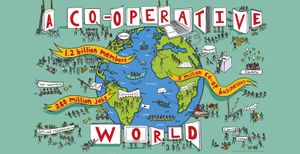Co-operatives UK
Co-operatives UK is the network for Britain's thousands of co-operatives who work to promote, develop and unite member-owned businesses. In 2020 they embarked on an ambitious programme of transforming their digital products and channels to remain competitive in the digital economy. As a long-standing member, Agile Collective was delighted to work with Co-operatives UK to help them achieve their digital transformation goals.
Co-operatives UK's website hadn't changed for several years and it was no longer supporting the needs of the organisation or its users. The brief identified many areas for improvement, with some high priorities being: the consolidation of a number of separate sites into a single platform; to improve the membership experience; and to simplify the consolidation process for co-ops. Also high on the list was a visual refresh to help them look more ‘business-like’ and visually consistent.
Discovery – user research and technical discovery
The discovery phase of the project was a collaborative process, with DotProject leading the user research and experience areas while we focused on the technical planning and design. The user research revealed many frustrations with the website – mainly around the difficulty of finding content – which was creating confusion and eroding the good work being done by Co-operatives UK. The navigation was the most commonly cited issue from both users and staff, with staff also saying that they struggled to find things on the multiple websites resulting in wasted time and frustration.
There are many different journeys on the Co-operatives UK websites but it is possible to break them down into four primary user journeys that form the backbone of a new Information Architecture putting the user experience up front.
Interestingly, the most common user need across all audiences was to understand what a co-op is!
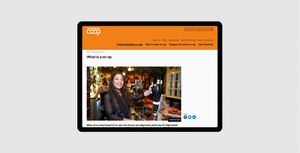
Consolidation
Over the years the Co-operatives UK web presence had expanded into a number of microsites, each for a specific externally-funded and branded programme and audience. The distribution of content and functionality across a number of platforms had led to a disjointed experience for end users, increased pressure on Co-operatives UK’s editorial team and an increasing maintenance overhead.
The user research uncovered that users were unlikely to mind which programme authored the content they needed, as long as they could find what they were looking for. So we created a flexible content model which enables editors to publish content relating to a ‘programme’, allowing that content to reside in the most user-friendly location on the site. At the same time we developed a consistent system for co-branding each of the programmes to maintain visibility without watering down the Co-operatives UK brand. In addition, content belonging to a specific programme is visually tagged so users are aware of its origin and can then navigate to the specific programme page if they want.
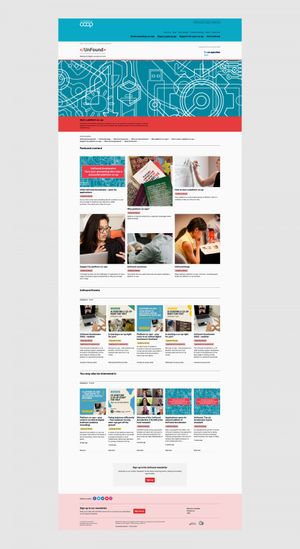
The membership experience
With over 7,000 individual member accounts associated with member organisations, members make up both a significant and very important proportion of Co-operatives UK’s digital audience. It was key that the website delivered a great experience for members.
Based on an integration with Salesforce via its REST API, users affiliated with a member organisation can log in to view and update their organisational and personal data, as well as accessing member-only content.
Additional complexity arose as we discovered that some people were likely to belong to more than one co-operative. We needed to design a solution that would allow a person to be able to create an account if they belonged to one or more member organisations, using as simple a process as possible. Knowing that these queries can take some time, we paid extra attention to giving users a speedy interaction.
Once logged in members are able to access gated member-only content, and with the addition of an HR Package, more content becomes available to them. Members can also check their organisation’s data is up to date so that they appear correctly in the Co-op Directory.
There are many plans for where to go next, but for this phase, the focus was on creating a solid foundation upon which to build in the future.
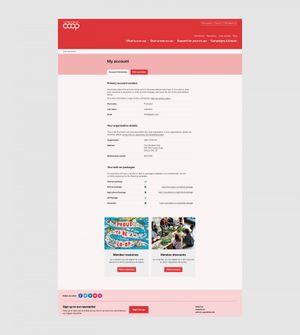
Improving the incorporation process
A core function of Co-operatives UK is the promotion and development of co-operatives. Providing clear guidance, support and a streamlined process of incorporation were critical for the project.
To do this we built a guidance tool based on the gov.uk step-by-step navigation pattern. This enabled users to explore the requirements for incorporation through a suggested rather than required journey, guiding users through the process from research and preparation to application in a way that allowed them to move at their own pace.
When ready, users could then begin the process of incorporation through a dynamic form that enabled them to save their progress and return when they were ready to provide the necessary detail. This was only phase one, however: following launch of the site, the process was further developed to include more integration with financial packages that support co-ops when getting started.
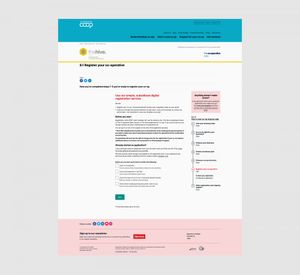
Directories
A useful feature on the previous site was a directory of co-operatives which allowed users to locate local co-operatives. Encouraging connection and collaboration across the co-operative sector is a key goal of Co-operatives UK and with a huge database of both member and non-member co-operatives, we knew it was crucial to expose this data. From speaking with users we knew that the previous directory hadn’t worked as intended and people hadn’t found the ‘locality’ functionality as useful as had initially been thought.
For this next iteration, we took the simplest approach, stripping back everything that we knew wasn’t working and building a much simpler directory with a more powerful search, enabling users to search by region, sector and type of co-op. We were then able to reuse this pattern for a new directory of practitioners which Co-operatives UK also wanted to roll out in this phase of work.

Visual design and brand development
The design of Co-operative UK’s website hadn’t changed for several years and had grown out of step with their evolving brand. They weren’t looking to completely rebrand and wanted to retain their logo and existing style guide, but there was still plenty of scope to create a new website which would look more ‘business-like but not corporate’ and which would present their content in a clearer, more engaging way.
There are many different types of content and some complex user journeys on the site which meant it was important to give users a sense of control and also to build trust in the site. To help achieve this the content has been designed to sit within a structured grid assisted by vertical and horizontal lines, which helps to both contain and separate content, making it easier to scan. Within this boxy structure, the ‘Featured content’ area introduces some air into the page by allowing for different image heights which are either top- or bottom-aligned.
Their existing colour palette was tweaked to be brighter and more accessible, and new typefaces were specified. We also introduced different coloured headers for each top level section to help reduce the amount of red across the site, which was a major concern of the comms team.
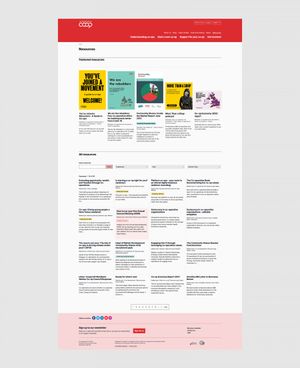
The result is a site which is responsive, easy to navigate, supports the needs of content editors and has enabled Co-operatives UK to deliver a better service for their members. Most important of all, the newly consolidated, accessible platform will play a key role in helping Co-operatives UK promote and assist the incorporation of new co-operatives.
